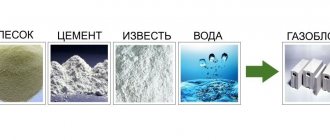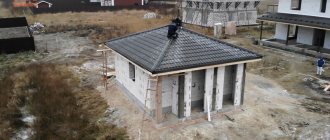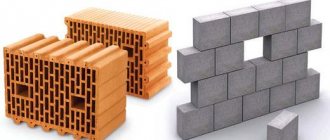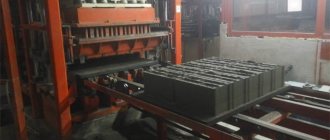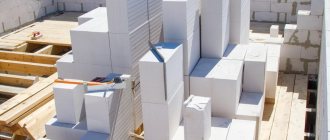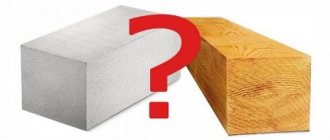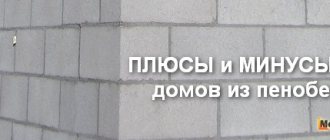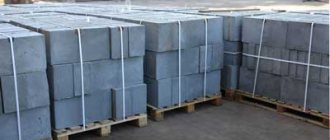In recent years, aerated concrete has become one of the most popular materials for masonry walls. The blocks are used both in private construction and on an industrial scale. Individual developers use them to build houses, garages, bathhouses, and utility rooms for various household needs. In the second case, gas blocks are used to construct partition walls between rooms (premises) inside multi-storey buildings.
Experts have mixed opinions about the pros and cons. The difference in assessment is due to the relatively short period of its mass use. Therefore, it is too early to make generalizations. There have been no fundamental studies of the behavior of aerated concrete blocks for several decades. Observations and measurements are carried out relatively recently. The overall picture is formed by reviews of private developers who do not always comply with construction technologies and blame “low-quality materials” rather than their own lack of professionalism and negligence.
At the same time, the quality of gas blocks that were produced 5-8 years ago and modern ones is radically different. Now there are dozens of companies on the market offering truly reliable building materials. One thing is certain: modern blocks are an affordable and reliable wall stone, quite suitable for the construction of objects with a service life of about 50-80 years.
What is a gas block
Aerated block is a universal building material.
It allows you to successfully cope with a number of construction tasks. Aerated concrete blocks are actively used in the construction of structures of various sizes and purposes, ranging from small frameless country houses to city skyscrapers. This material is also often used in the construction of shopping and entertainment complexes. The technology of construction from aerated block is not particularly complicated. Today on the Internet you can find not only step-by-step construction instructions, but also many different videos from both professionals and amateurs, clearly demonstrating the entire process from scratch.
The large dimensions and light weight of the material can significantly reduce the construction time of the building and the cost of paying for construction services. However, this does not mean that you can hire the first janitor you come across from neighboring countries instead of a construction crew. The main thing when working with any material is strict adherence to technology. If a company or team works under a contract and values its reputation, it will not make mistakes. While temporary employees are interested in the speed and simplicity of their work, but not in quality.
In addition, if you have certain skills, you can make from aerated concrete:
- columns;
- stands;
- bedside tables;
- decorative decorations that imitate stucco.
In other words, aerated concrete products can be used as a finishing and decorative material.
pros
Gas silicate blocks, the cost of which allows you to reduce the cost of building a house, boast the following advantages:
- Light weight . The presented material has a mass that is 5 times less than the weight of a similar concrete product. Thanks to this quality, it is possible to reduce the cost of transportation and installation of material.
- High strength properties for mechanical compression . If you use a D500 block, its strength can be 40 kg/cm3.
- The thermal resistance value will be 8 times higher than that of concrete. The presence of a porous structure makes it possible to obtain excellent thermal insulation performance.
- Gas silicate blocks are characterized by their heat-saving properties . Such products can release the accumulated thermal energy inside the room, as a result of which you can save on heating costs.
- The presence of pores allows you to obtain high sound insulation rates, which are 10 times higher than that of brick.
- The material does not contain various toxic components , so it is an environmentally friendly product.
- Gas silicate is not characterized by non-flammability . The material can withstand direct fire for 3 hours. As a result, it is possible to eliminate situations with the spread of flame.
- The vapor permeability indicators of the blocks are much higher compared to their opponents. It is reliably known that gas silicate is able to “breathe”, as a result of which comfortable living conditions are created inside the house.
How frost-resistant adhesive is used for gas silicate blocks can be found in this article.
The video talks about the pros and cons of gas silicate blocks:
You can find out from this article which is better aerated concrete, foam concrete or gas silicate blocks.
Aerated block house: reviews
Below are the positive and negative aspects of building with aerated concrete. They were compiled based on reviews from owners living in houses made of aerated concrete blocks, as well as our opinion as a developer who knows first-hand about the properties of this type of material.
"For" construction
Our developer opinion
- With fairly large dimensions, the gas block has a relatively low weight (400-500 kg/m2). This reduces the load on the foundation of the building.
- If you lay blocks using the thin joint method, the mortar consumption will decrease by 5-6 times, compared with traditional masonry.
- The material has high compressive strength - 30-40 kgf/m2, which makes it possible to use it for the construction of frameless structures up to 14 m high, as well as for the construction of partitions and internal walls.
- Compared to wood, aerated concrete has a longer service life and is easier to work with during installation. Read: Should the wall of a house breathe?
- Material of this kind does not burn and does not contribute to the development of combustion. It can contain the fire and prevent it from escaping in/out for 4-6 hours.
- No special equipment is required to work with a gas block. It can be easily processed with conventional hand or power tools. It is easy to saw, cut, sand, drill and split.
Owners' opinion
- In 2022, building a house frame from aerated concrete will cost less than from brick, wood or expanded clay concrete.
- To work with this type of material, no special lifting mechanisms are required. This significantly reduces labor costs.
- The service life of aerated concrete is approximately equal to that of conventional bricks, and it is cheaper. Manufacturers of aerated concrete blocks guarantee the preservation of the original qualities of the material for at least 80 years. The first reconstruction work may be needed after 120-150 years, if the building is properly maintained.
- A house built from aerated blocks warms up to a comfortable temperature in just a few hours, which cannot be said about brick buildings.
- Walls made of this type of building material are always warm to the touch. This is explained by the good heat-saving qualities of the blocks.
- The porous structure of the building material absorbs street noise very well.
You can build not only country houses or houses for permanent residence from aerated blocks. This building material is perfect for constructing a garage, bathhouse, fence, fence and shed. It is also often used for adding a second floor, reconstructing outdated structures and constructing attics.
“Against” construction
Our developer opinion
- The carcinogenicity and hygroscopicity of aerated concrete still causes a lot of controversy. In Germany, for example, aerated concrete blocks have been banned since 2012. The dangers of aerated concrete have been known for a long time. During the production and use of this material, toxic fumarolic gases are released, the main components of which are phosphorus, chlorine and sulfur compounds. Also, due to their porous structure, aerated concrete is hygroscopic; it intensively absorbs moisture from the environment, so it is an excellent breeding ground for fungi and mold. However, if you strictly follow the construction technology, then at least the issue of hygroscopicity can be resolved, then you won’t have to think about fungus and mold.
- When building a house of two or three floors, it is undesirable to use aerated concrete blocks as the main load-bearing material. An acceptable option would be to lay load-bearing walls from aerated concrete blocks of a grade higher than D-600, which has a high density. It should be noted that the higher the density, the lower the thermal insulation properties of the building material. Accordingly, more insulation will be needed, and this is associated with additional financial costs.
- Practice shows that even when laying aerated concrete by experienced craftsmen, about 15% of the material cracks. This can be caused by errors when pouring the foundation, soil movements, shrinkage of blocks, etc. The appearance of cracks will not cause significant damage to the building, but will spoil the appearance.
- When finishing the house, it is important to follow the sequence of work, otherwise the gas blocks will absorb too much moisture and this will negatively affect their service life. First, interior work should be done - this will reduce the humidity inside the building. Then you can begin insulation and external wall cladding.
- When building houses from aerated concrete, it is necessary to reinforce the walls. It is best to strengthen every fourth row of blocks. Otherwise, the likelihood of cracks appearing in the walls increases.
Owners' opinion
- Even if work is forced to be interrupted, the unfinished object should be preserved for the winter, otherwise the blocks may crack and lose some of their positive properties.
- Walls made of aerated blocks need immediate finishing. This is due to the fact that the material is able to absorb moisture from the environment. In this situation, the source of dampness can be not only rain or snow, but also fog.
- Mixtures used for finishing work are poorly retained on aerated concrete walls. In this regard, it is necessary to double-prime the walls, treat them with sandpaper or reinforce them with a polymer mesh.
- To hang something heavy on an aerated concrete wall, such as a water heater, a wall cabinet or a bulky shelf, you need to use special fasteners. Conventional fasteners do not hold well and do not last long.
- If difficulties arise with decorative finishing, it is necessary to use special glue, primer or plaster.
By weighing all the pros and cons, you can understand whether a gas block is suitable for building your home. You should also study the characteristics of other building materials and find out their advantages and disadvantages.
Developers and owners of houses made of aerated concrete blocks agree on one thing – the costs of constructing buildings made of aerated concrete blocks are within the means of most middle-class representatives.
What are gas silicate blocks and how to use them?
Gas silicate blocks are a building material that is light in weight and large in size. It allows you to significantly reduce the overall weight of your building, as well as save money on the foundation and thermal insulation, but at the same time it will require additional strengthening of load-bearing and main walls and the cost of high-quality waterproofing. Problems can only arise with the internal plaster of houses made of gas silicate blocks.
Foreman's advice : these features are preserved only if the blocks were manufactured in compliance with all technologies. Therefore, before purchasing materials, you should find out about the manufacturer, read reviews, or better yet, ask for advice from friends who have already used products from this manufacturer.
This is due to the fact that this building material is characterized by low strength at high humidity. Thus, you will need to use materials for finishing (both external and internal) that will prevent moisture from entering the blocks. This can be either ordinary roll waterproofing or isover, which will give an additional insulation effect.
Such houses are energy efficient because they retain temperature well. In winter, this will allow you to save up to 40-45% on heating your home.
Foreman's advice : insulating houses made of gas silicate blocks is also a necessary measure, which will not only better retain heat, but also provide additional protection for the walls.
Strengthening external walls can be done with the help of beams, which will prevent the building from cracking and subsidence in the future under its own weight. If the walls are not strengthened, then the subsidence can be significant, especially if the building is not a one-story house, and can reach 5%, which will lead to serious violations of their integrity.
If you follow all the rules and regulations of construction, you can quickly build a warm, energy-efficient and environmentally friendly house. Look at the pros and cons of gas silicate blocks for yourself.
Photo: house made of gas silicate blocks
Reviews
- Andrey, expert : “Gas silicate blocks have a porous structure, as a result of which the house “breathes.” The structures are also capable of retaining thermal energy. Although the dimensions of this material are 600X300X200, it weighs a little. Construction of the house is very easy and simple. You will need only 2 weeks to completely build the house. The result of the work done will be a warm and cozy home. In addition, the constructed structure has a fairly long service life.”
- Yuri: “I built my house from gas silicate in the fall, but it was not possible to complete the finishing before the onset of cold weather. As a result, the walls became saturated with water and began to emit an unpleasant odor. From the outside, the blocks begin to collapse. Only after consulting with a specialist, I realized that only internal walls and partitions needed to be built.”
- Andrey: “I purchased gas silicate blocks from a trusted manufacturer, and the installation process was carried out according to technology. I built a two-story house and for 5 years no cracks or other flaws have been found on the surface. For the construction of the walls I used D400 material, and used an adhesive composition for coupling. To finish the façade, I initially used a mesh and made a concrete belt.”
You can learn about the cost of an expanded clay concrete block from this article.
Gas silicate blocks are an excellent material for the construction of internal partitions. Of course, it can also be used for the construction of external walls. But, as experience shows, such houses begin to quickly collapse and crack. In any case, before building your house, you should consult with a specialist.

